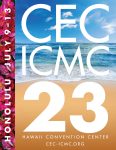Presentation Upload – Indico
- All presenters are encouraged to upload an electronic copy of their presentation prior to their talk at the scheduled CEC/ICMC’23 session.
- By participating at CEC/ICMC’23 and submitting your presentation, you implicitly agree to publish the content of your presentation on the public Indico site. Presentations will be available indefinitely unless it is removed by the author.
- Presentation upload instructions are available here.
Presentation Upload – Onsite at the Conference
- Presenters are REQUIRED to submit an electronic version of their talk at least one day prior to their presentation to the Speaker Ready Room (Room 322). Files are reviewed, scanned for viruses, and loaded onto the appropriate computers in the session rooms. Changes to submitted files will not be allowed.
- Only material that corresponds to the listing in the published program may be submitted for presentation. Presentation management staff will be instructed to check for discrepancies.
- All presentations will be deleted from all conference computers. It is not possible to copy presentation files
Logistics/Presentation Information
- Your presentation must correspond to the title and content of the abstract you submitted.
- Presentations will be given using the computers provided by the CEC/ICMC’23 Conference. Presenters’ personal computers cannot be used.
- Using removable media (USB drives) is prohibited on the computers in oral session rooms. Saving data to and from them is not possible.
- Files transferred to the session computers cannot be copied by anyone and will be deleted after the Conference. Anyone wishing to receive a copy of the slides should contact the presenter, not CEC/ICMC’23 staff or organizers.
- Presentations must be submitted in Microsoft Power Point 2019/PowerPoint 365 or PDF format. Acceptable media: USB flash drive. Macintosh computers will not be available in any of the session rooms. Authors using a Macintosh must ensure their presentations operate correctly using Microsoft Office 2018/2019/365 or Adobe Acrobat in the Windows environment.
- Presentations should be prepared in 16:9 format.
- All session rooms are equipped with an LCD projector, computer, microphones, laser pointer, timer and screen. The laptops in the oral session rooms are not equipped to accommodate audio sound.
- Contributed oral presentations are 15 minutes: arrange your talk so that your presentation lasts 12 – 13 minutes with 2 – 3 minutes available for questions.
- Most invited presentations are 30 minutes: arrange your talk so that your presentation lasts 25 minutes with 5 minutes available for questions.
- Invited presentation at 20 minutes: arrange your talk so that your presentation lasts 16 – 18 minutes with 2 – 4 minutes available for questions.
- If your invited presentation is scheduled for 15 minutes, please follow the contributed oral presentation guidelines above.
- Arrive a few minutes before the session and introduce yourself to the session chairs before the start of the session.
- There will be no rearrangement of papers within an oral session to accommodate absences or cancellations. The time assigned to an oral presentation within the oral session is fixed.
Speaker Ready Room (322) Hours of Operation
| Sunday, July 9 | 3:00 p.m. – 7:00 p.m. | |
| Monday, July 10 | 7:00 a.m. – 6:30 p.m. | |
| Tuesday, July 11 | 7:00 a.m. – 7:00 p.m. | |
| Wednesday, July 12 | 7:00 a.m. – 6:30 p.m. | |
| Thursday, July 13 | 7:00 a.m. – 10:00 a.m. | |
Presentation Guidelines
- Content Organization
- Plan one slide per minute: 8 to 12 slides for Contributed Oral, and up to 25 slides per Invited Oral.
- Carefully budget your time. Allocate at least one minute to describe the problem clearly enough for the audience to appreciate the value of your contribution.
- Make sure the audience walks away understanding the five things any listener to a presentation really cares about:
- What is the problem and why?
- What has been done about it?
- What is the presenter doing (or has done) about it?
- What additional value does the presenter’s approach provide?
- Where do we go from here?
- Fonts
- Select a Sans-serif fonts: Arial or Helvetica. Avoid Serif fonts such as Times New Roman: the Serif fonts are more difficult to read.
- Select font size to be visible over the whole room. We recommend font 24. Do not use fonts less than 18 points.
- Consider font embedding to ensure that characters display properly.
- Use larger fonts to indicate importance.
- Use different sizes and styles (e.g., bold) for impact. Avoid italicized fonts as these are difficult to read quickly.
- Avoid long sentences, Avoid abbreviations and acronyms. Limit punctuation marks.
- No more than six lines per slide, and no more than 6-8 words per line.
- Do not use all caps except for titles.
- Design and Graphical Images
- Include only necessary information: Content should be self-evident.
- Keep the background consistent and subtle.
- Use one or two large images rather than several small images.
- Limit the tables to four rows/columns for readability.
- Charts: The number of curves should be four or less. Label axes, curves and captions clearly using readable letters, font 18 or larger.
- Limit the number of colors on a single screen.
- Keep the design clean and uncluttered. Leave empty space around the text and graphical images.
- Limit the number of graphical images on each slide.
- Avoid sound effects.
- Minimize animation.
More helpful tips can be found here.

